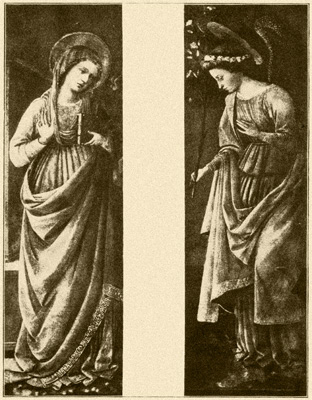The Archangel Gabriel is mentioned by name but twice in the Old Testament. First in Daniel viii., 16, when he explained the vision which the prophet had seen, and again in Daniel ix., 21, when Gabriel appeared to Daniel to give him skill and understanding.
Likewise in the New Testament he is twice mentioned– in Luke i., 19 and 26, when he announced to Zacharias the birth of John the Baptist, and to the Virgin Mary that she was favored of the Lord, and blessed among women. On each of those occasions he filled the office of a messenger or bearer of important tidings. It is believed to have been Gabriel who fought with the Angel of the Kingdom of Persia for twenty-one days, when Michael came to his relief, and Gabriel again visited Daniel to strengthen him, and explain “that which is noted in the scripture of truth,” and to announce that the king of Greece should overcome the king of Persia. After which Gabriel returned to his battle with the Angel of Persia.
The contest with the angel of Persia is a subject which offers unusual opportunities in its artistic representation; it is, however, much the same in spirit as the struggle between Michael and Lucifer, and the preference was given to the latter by the painters of religious subjects.
St. Gabriel has been many times portrayed as the messenger announcing the birth of John the Baptist and that of Jesus Christ. In the apocryphal legends he also foretells the birth of Samson, and that of the Virgin Mary. From these frequently repeated messages which foretold important births, Gabriel naturally came to be regarded as the angel who presides over childbirth.
The great number of representations of the Annunciation to the Virgin Mary make it difficult to select those of which to speak. The earliest pictures of this event portray it with great simplicity, purity, and grace. A spiritual mystery is being depicted, and is handled with sincere reverence and the utmost delicacy.
The scene is usually the portico of an ecclesiastical edifice. When seated, the Virgin is on a species of throne, but she is more frequently represented as standing. The archangel is at some distance from her, not infrequently quite outside the porch. He is majestic and beautiful; is clothed in white, wearing the tunic and pallium or archbishop’s mantle. His wings are large, and brilliant with many colors, and his abundant hair is bound with a jeweled tiara. He bears either the sceptre of power or a lily in one hand, while the other is extended in benediction. Sometimes he holds a scroll inscribed with the words, “Ave Maria, gratia plena.” Hail! Mary, full of grace, the words Dante represents Gabriel as constantly repeating in paradise.
The angel is the chief figure in this scene in the earlier pictures; he is joyfully triumphant, announcing the coming of the Saviour, while the Virgin is all humility and submission; in some cases her head is covered, an extreme expression of lowliness, and she is always self-effacing in attitude and expression.
 A Divided Annunciation by Fra Filippo Lippi
A Divided Annunciation by Fra Filippo Lippi
An early custom in churches was to place the picture of the Virgin on one side of the altar, and that of the angel the other side; or, if both figures were in the same frame, a division was made by an architectural pillar, or a conventional ornament between them. In many cases the Virgin and the Archangel were placed separately above, or on each side of some scene from the life of Jesus, usually an altar piece. The picture by Fra Filippo Lippi, shown above, is a very fine example of the so-called “divided Annunciations.” It is in the Florentine Academy. This picture is very beautiful, and fittingly expresses the humility and surprise of the Virgin and the reverence of the heavenly messenger. It is also a good example of Fra Filippo’s style; his draperies were graceful, abundant, and usually much ornamented with signs in gold, of which we have here, enough for elegance, while it is not overdone as in other works of this artist.
Source: Clement, Clara Erskine. Angels in Art. Boston: L.C. Page and Company, 1898.
Be sure to visit Christian Image Source for more free illustrations of Archangel Gabriel.
 Archangel Pictures
Archangel Pictures